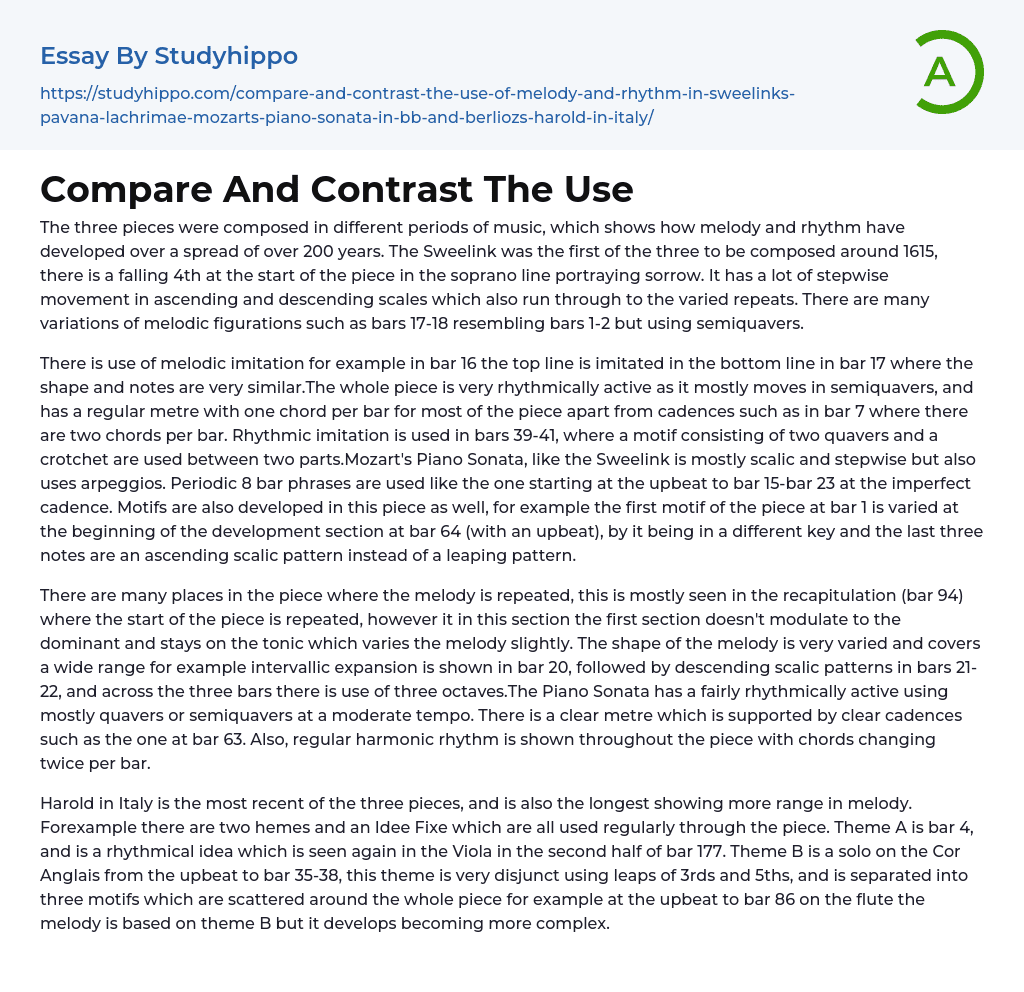The three pieces were composed in different periods of music, which shows how melody and rhythm have developed over a spread of over 200 years. The Sweelink was the first of the three to be composed around 1615, there is a falling 4th at the start of the piece in the soprano line portraying sorrow. It has a lot of stepwise movement in ascending and descending scales which also run through to the varied repeats. There are many variations of melodic figurations such as bars 17-18 resembling bars 1-2 but using semiquavers.
There is use of melodic imitation for example in bar 16 the top line is imitated in the bottom line in bar 17 where the shape and notes are very similar.The whole piece is very rhythmically active as it mostly moves in sem
...iquavers, and has a regular metre with one chord per bar for most of the piece apart from cadences such as in bar 7 where there are two chords per bar. Rhythmic imitation is used in bars 39-41, where a motif consisting of two quavers and a crotchet are used between two parts.Mozart's Piano Sonata, like the Sweelink is mostly scalic and stepwise but also uses arpeggios. Periodic 8 bar phrases are used like the one starting at the upbeat to bar 15-bar 23 at the imperfect cadence. Motifs are also developed in this piece as well, for example the first motif of the piece at bar 1 is varied at the beginning of the development section at bar 64 (with an upbeat), by it being in a different key and the last three notes are an ascending scalic pattern instea
of a leaping pattern.
There are many places in the piece where the melody is repeated, this is mostly seen in the recapitulation (bar 94) where the start of the piece is repeated, however it in this section the first section doesn't modulate to the dominant and stays on the tonic which varies the melody slightly. The shape of the melody is very varied and covers a wide range for example intervallic expansion is shown in bar 20, followed by descending scalic patterns in bars 21-22, and across the three bars there is use of three octaves.The Piano Sonata has a fairly rhythmically active using mostly quavers or semiquavers at a moderate tempo. There is a clear metre which is supported by clear cadences such as the one at bar 63. Also, regular harmonic rhythm is shown throughout the piece with chords changing twice per bar.
Harold in Italy is the most recent of the three pieces, and is also the longest showing more range in melody. Forexample there are two hemes and an Idee Fixe which are all used regularly through the piece. Theme A is bar 4, and is a rhythmical idea which is seen again in the Viola in the second half of bar 177. Theme B is a solo on the Cor Anglais from the upbeat to bar 35-38, this theme is very disjunct using leaps of 3rds and 5ths, and is separated into three motifs which are scattered around the whole piece for example at the upbeat to bar 86 on the flute the melody is based on theme B but it develops becoming more complex.
The Idee Fixe starts at
bar 65 and represents Harold as a main theme. The Idee Fixe returns a lot during the piece for example in the flute at bar 152, this is in the coda where all of the theme are brought together creating thematic unity. In the coda all three themes are played at the same time for example at bar 180 the Flute is playing the Idee Fixe whilst the Viola solo is playing theme B and the Violas are replicating theme A.Compared the the previous two pieces this piece is slow rhythmically using much longer and sustained notes, however there is a clear metre. The tempo of the piece changes which is also different to the other two pieces, it slows down in the second section (bar 32) to half the speed of the first section.
In this section the Idee Fixe is played in the Viola first at bar 65, when it enters it seems a lot slower than the rest of the orchestra. At bar 49, the orchestra becomes more rhythmically active with many parts having rhythmically independent parts. In bar 37 the Cor Anglias has syncopation but there is a strong pulse in the accompaniment keeping the beat. At the coda (bar 166) there is use of cross rhythms between the violas and the rest of the orchestra, this is because the Violas are playing double speed in 6/8 time, which is the same tempo as the first section, whereas the rest of the orchestra are playing at the speed of which the section section was being played.
- Band essays
- Baroque Music essays
- Blues essays
- Classical Concert essays
- Classical Music essays
- Concert essays
- Hip Hop essays
- Jazz essays
- Ludwig Van Beethoven essays
- Michael Jackson essays
- Mp3 essays
- Music Concert Report essays
- Music Reference essays
- Music video essays
- Musical Instruments essays
- Opera essays
- Piano essays
- Popular music essays
- Recording essays
- Rock And Roll essays
- Rock Music essays
- Singing essays
- Sonata essays
- Song essays
- Sonnet essays
- Tupac shakur essays
- John Locke essays
- 9/11 essays
- A Good Teacher essays
- A Healthy Diet essays
- A Modest Proposal essays
- A&P essays
- Academic Achievement essays
- Achievement essays
- Achieving goals essays
- Admission essays
- Advantages And Disadvantages Of Internet essays
- Alcoholic drinks essays
- Ammonia essays
- Analytical essays
- Ancient Olympic Games essays
- APA essays
- Arabian Peninsula essays
- Argument essays
- Argumentative essays
- Art essays
- Atlantic Ocean essays
- Auto-ethnography essays
- Autobiography essays
- Ballad essays




